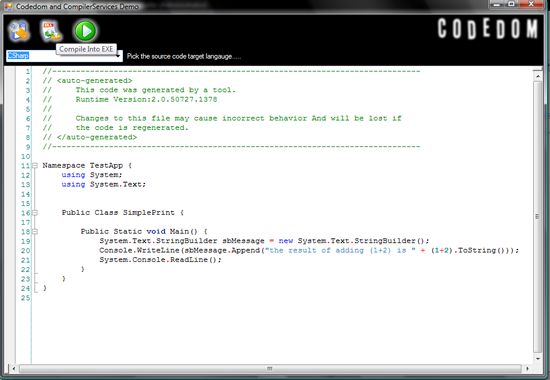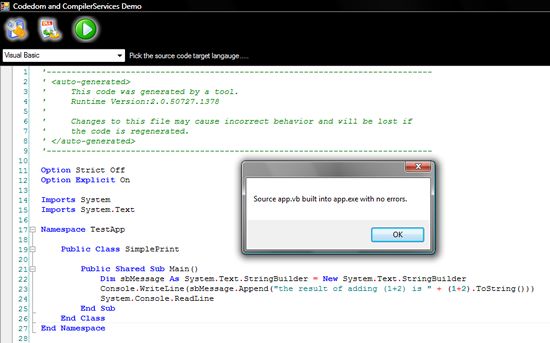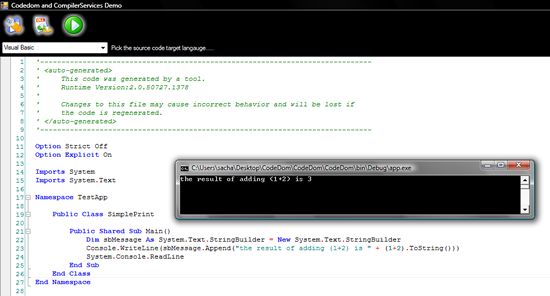强烈推荐
CODEDOM学习系列:http://www.cnblogs.com/lichdr/category/12610.html
.net项目的二次开发解决方案 :http://www.cnblogs.com/nuaalfm/archive/2008/11/14/1333381.html
反射插件应用系列:http://www.cnblogs.com/nuaalfm/archive/2008/09/08/1286640.html
转载几篇英文文章:
http://www.codeproject.com/KB/cs/CodeDomCompile.aspx
Download demo project (VS2008) - 1,840 Kb

Introduction
This is a bit of a strange article, and may not be that useful, but I think its a very interesting subject, that some will probably not even be aware of. This article will cover some of the less known namespaces within .NET. Such as System.CodeDom and System.CodeDom.Compiler. What I will be demonstrating in this article, is just how neat these namespaces are and what can be done with them. Specifically I will be demonstrating that we are able to build entirely new source code files at runtime using the System.CodeDom namespace and the use the System.CodeDom.Compiler namespace classes to even compile this newly created source code into a runnable application. This will all be created at runtime. My aim for this article is to provide a simple introduction into these 2 namespaces, you will not be an expert at the end of this article, but will have been exposed to enough, to realise what these 2 namespaces allow you to achieve.
Why Would I Want To Create New Source Code And Applications At Runtime
Well the reason that I started looking into this was dynamic code generation for Data Access Layers (DAL) /Business Access Layer (BAL) code based on an initial schema. So thats one possible area where it may be useful to create code at runtime, basically have an application create a bunch of auto generated source code files that can then be used within another project. Thats just where we (at work) found a use for this stuff.
This led me onto investigating the the System.CodeDom.Compiler namespace classes, and as such I thought I would spend a bit of time talking about the possibilities that are available by using these classes.
The rest of this article will be split roughly between a discussion about the System.CodeDom namespace, and the System.CodeDom.Compiler namespace. And finally a short discussion of what the attached demo application will be discussed.
System.CodeDom
The System.CodeDom namespace, contains classes, interface and enmerations that can be used to create source code at runtime. The general idea is that a newly constructed Document Object Model is being created, where methods, constructors using directives, variables are all creatable via using the System.CodeDom namespace. Where CodeDom really comes into its own is that it is lanuage agnostic and simply provides a CodeCompileUnit which can then be used by the System.CodeDom.Compiler namespace which uses this CodeCompileUnit to create the source code in any of the .NET languages
I shall demonstrate a few examples of using the CodeDom.
Creating Namespaces
 Collapse
Collapse
 Copy Code
Copy Code
CodeNamespace ns = new CodeNamespace("TestApp");
ns.Imports.Add(new CodeNamespaceImport("System"));
ns.Imports.Add(new CodeNamespaceImport("System.Text"));
compileUnit.Namespaces.Add(ns);
Creating A Class
 Collapse
Collapse
 Copy Code
Copy Code
CodeTypeDeclaration ctd = new CodeTypeDeclaration(Name);
ctd.IsClass = true;
ctd.Attributes = MemberAttributes.Public;
compileUnit.Namespaces[0].Types.Add(ctd);
Creating A Main Method
 Collapse
Collapse
 Copy Code
Copy Code
CodeEntryPointMethod method = new CodeEntryPointMethod();
method.Attributes = MemberAttributes.Public |
MemberAttributes.Static;
ctd.Members.Add(method);
Obviously this only gives you a very small example of what CodeDom is like to work with. I have to say the syntax is very verbose, but the fact that you can create any .NET source from CodeDom, makes it quite appealing. There are also some good wrappers around CodeDom, which shorten the syntax, I have included a list of related articles at the bottom of this article, should you wish to read around this subject a bit more.
System.CodeDom.Compiler
If we want to be able to use the System.CodeDom.Compiler namespace to compile the result of building a CodeDom object, we need to make sure that wherever we built our CodeDom object (using the syntax as shown above) that we return a CodeCompileUnit. It is by using this CodeCompileUnit that we are able to use the System.CodeDom.Compiler namespace, to create the source code in any of the .NET languages.
For example this excerpt of the demo applications code, shows how we built a new source code file using the System.CodeDom and System.CodeDom.Compiler namespaces.
 Collapse
Collapse
 Copy Code
Copy Code
private void picGenerate_Click(object sender, EventArgs e)
{
CodeDomProvider domProvider = (CodeDomProvider)getCodeEditorSyntaxOrProvdiderForLanguage
(cmbPickLanguage.SelectedItem.ToString(),false);
cde.GenerateCode(domProvider, cde.BuildSimpleAdder());
using (StreamReader sr = new StreamReader(getSourceFileName(domProvider)))
{
txtCode.Document.Text = sr.ReadToEnd();
sr.Close();
}
}
....
....
private object getCodeEditorSyntaxOrProvdiderForLanguage(string selectedLanguage, bool syntaxObjectRequired)
{
switch (selectedLanguage)
{
case "CSharp":
if (syntaxObjectRequired)
return SyntaxLanguage.CSharp;
else
return CodeDomProvider.CreateProvider("CSharp");
case "Visual Basic":
if (syntaxObjectRequired)
return SyntaxLanguage.VBNET;
else
return CodeDomProvider.CreateProvider("VisualBasic");
default:
if (syntaxObjectRequired)
return SyntaxLanguage.CSharp;
else
return CodeDomProvider.CreateProvider("CSharp");
}
}
....
....
private string getSourceFileName(CodeDomProvider domProvider)
{
if (domProvider.FileExtension[0] == '.')
{
return "app" + domProvider.FileExtension;
}
else
{
return "app." + domProvider.FileExtension;
}
}
....
....
public CodeCompileUnit BuildSimpleAdder()
{
CodeCompileUnit compileUnit = new CodeCompileUnit();
compileUnit.Namespaces.Add(InitializeNameSpace("TestApp"));
CodeTypeDeclaration ctd = CreateClass("SimplePrint");
compileUnit.Namespaces[0].Types.Add(ctd);
CodeEntryPointMethod mtd = CreateMainMethod();
ctd.Members.Add(mtd);
CodeVariableDeclarationStatement VariableDeclaration =
DeclareVariables(typeof(StringBuilder), "sbMessage");
mtd.Statements.Add(VariableDeclaration);
mtd.Statements.Add(new CodeSnippetExpression(
"Console.WriteLine(sbMessage.Append(\"the result of adding (1+2) is \" + " +
"(1+2).ToString()))"));
CodeTypeReferenceExpression csSystemConsoleType =
new CodeTypeReferenceExpression("System.Console");
CodeMethodInvokeExpression csReadLine =
new CodeMethodInvokeExpression(csSystemConsoleType, "ReadLine");
mtd.Statements.Add(csReadLine);
return compileUnit;
}
....
....
public void GenerateCode(CodeDomProvider domProvider, CodeCompileUnit compileunit)
{
String srcFile;
if (domProvider.FileExtension[0] == '.')
{
srcFile = "app" + domProvider.FileExtension;
}
else
{
srcFile = "app." + domProvider.FileExtension;
}
using (IndentedTextWriter tw = new IndentedTextWriter(new StreamWriter(srcFile, false), " "))
{
domProvider.GenerateCodeFromCompileUnit(compileunit, tw, new CodeGeneratorOptions());
tw.Close();
}
}
So doing this is enough to create a new source code file, in any of the .NET languages. This is all thanks for the CodeDomProvider class, which is able to create providers for all of the .NET languages. So providing we use the the relevant CodeDomProvider for the CodeCompileUnit that came out of using CodeDom can be generated into a source code any of the .NET languages. Neat Huh.
So what have we got so far, well we create a DOM representing a new class, which eventually gave us a CodeCompileUnit that we then used to create the relevant source code by using the specfic e CodeDomProvider class, for the language we wanted to generate.
So thats cool, we have a source code file. But at the top of this article I also said that I would show you how to compile source code into an Assembly or an Exe. So lets continue to look at that.
Again I think the best thing to show you is the relavant source code.
 Collapse
Collapse
 Copy Code
Copy Code
private void picCompile_Click(object sender, EventArgs e)
{
CodeDomProvider domProvider = (CodeDomProvider)getCodeEditorSyntaxOrProvdiderForLanguage
(cmbPickLanguage.SelectedItem.ToString(), false);
string srcFile = getSourceFileName(domProvider);
CompilerResults cr = cde.Compile(domProvider,srcFile,"app.exe");
string message = string.Empty;
if (cr.Errors.Count > 0)
{
message+= "Errors encountered while building " +
srcFile + " into " + cr.PathToAssembly + ": \r\n\n";
foreach (CompilerError ce in cr.Errors)
message +=ce.ToString() + "\r\n";
picRun.Enabled = false;
MessageBox.Show(message);
}
else
{
message += "Source " + srcFile + " built into " +
cr.PathToAssembly + " with no errors.";
picRun.Enabled = true;
MessageBox.Show(message);
}
}
....
....
private object getCodeEditorSyntaxOrProvdiderForLanguage(string selectedLanguage, bool syntaxObjectRequired)
{
switch (selectedLanguage)
{
case "CSharp":
if (syntaxObjectRequired)
return SyntaxLanguage.CSharp;
else
return CodeDomProvider.CreateProvider("CSharp");
case "Visual Basic":
if (syntaxObjectRequired)
return SyntaxLanguage.VBNET;
else
return CodeDomProvider.CreateProvider("VisualBasic");
default:
if (syntaxObjectRequired)
return SyntaxLanguage.CSharp;
else
return CodeDomProvider.CreateProvider("CSharp");
}
}
....
....
private string getSourceFileName(CodeDomProvider domProvider)
{
if (domProvider.FileExtension[0] == '.')
{
return "app" + domProvider.FileExtension;
}
else
{
return "app." + domProvider.FileExtension;
}
}
....
....
public CompilerResults Compile(CodeDomProvider domProvider, String srcFile,String exeFile)
{
String[] referenceAssemblies = { "System.dll" };
CompilerParameters cp = new CompilerParameters(referenceAssemblies,exeFile, false);
cp.GenerateExecutable = true;
CompilerResults compiledResults = domProvider.CompileAssemblyFromFile(cp, srcFile);
return compiledResults;
}
And that is enough to get us a EXE created for the source code that we created earlier. Remember this is all being done at runtime, I think thats pretty cool actually. Create a new source code and compile and run it at runtime. That's neat.
The DEMO Application
Anyway, lets just have a quick chat about the demo app. I use the fantastic Fireball code highlighter, available right here at Codeproject. And the basic program that I am trying to create at runtime is as follows
 Collapse
Collapse
 Copy Code
Copy Code
Namespace TestApp {
using System;
using System.Text;
Public Class SimplePrint {
Public Static void Main() {
System.Text.StringBuilder sbMessage = new System.Text.StringBuilder();
Console.WriteLine(sbMessage.Append("the result of adding (1+2) is " + (1+2).ToString()));
System.Console.ReadLine();
}
}
}
Which when generated in Visual Basic .NET, looks as follows:
 Collapse
Collapse
 Copy Code
Copy Code
Option Strict Off
Option Explicit On
Imports System
Imports System.Text
Namespace TestApp
Public Class SimplePrint
Public Shared Sub Main()
Dim sbMessage As System.Text.StringBuilder = New System.Text.StringBuilder
Console.WriteLine(sbMessage.Append("the result of adding (1+2) is " + (1+2).ToString()))
System.Console.ReadLine
End Sub
End Class
End Namespace
And the demo application looks like this, where there are 3 buttons:
- Generate button : generates the source code
- Compile button : compiles the source code
- Run : runs the newly compiled app
Here is a screen shot of the demo app, just after a generate and compile being performed, where the selected .NET language was Visual Basic

And here is the actual newly created application runnning

And thats about it. Like I say, you are by no means an expert from reading this, but I hope its given you an idea about what can be done with these 2 very cool namespaces.
Other CodeDom Resources
msdn2.microsoft.com/en-us/library/system.codedom.aspx
msdn2.microsoft.com/en-us/library/system.codedom.compiler(VS.71).aspx
http://msdn2.microsoft.com/en-us/library/system.codedom.compiler.codedomprovider.aspx
codedom_assistant.aspx
refly.aspx
http://www.codeproject.com/KB/recipes/codedomparser.aspx
http://www.codeproject.com/KB/architecture/codedompatterns.aspx#CodePatternCompileUnit
http://www.codeproject.com/KB/database/ObjectMapping2.aspx
Future Work
I may end up elaborating on this article in the fiture to discuss how the process of code generation can be handled more efficienly using some of the Visual Studio SDK tools.
History
27/01/08 : Initial Issue
Describes a collection of WebReference objects.
By Code Collector
Printer Friendly Version
View My FAQ's
|
 |
| References: Initialize, Read, Create, Generate, Import, Main, Compile, Print, CollectionBase, CodeCompileUnit, CodeNamespace, CodeDomProvider, Report, WebReferenceOptions |
Describes a collection of WebReference objects. |
|
|
|
public sealed class WebReferenceCollection : CollectionBase
using System;
using System.CodeDom;
using System.CodeDom.Compiler;
using System.Security.Permissions;
using System.Web.Services;
using System.Web.Services.Description;
using System.Web.Services.Discovery;
using System.Xml;
using System.Xml.Serialization;
class Test
{
[SecurityPermissionAttribute(SecurityAction.Demand, Unrestricted=true)]
static void Run(){
// Get a WSDL file describing a service.
ServiceDescription description = ServiceDescription.Read("DataTypes_CS.wsdl");
// Initialize a service description importer.
ServiceDescriptionImporter importer = new ServiceDescriptionImporter();
importer.ProtocolName = "Soap12"; // Use SOAP 1.2.
importer.AddServiceDescription(description,null,null);
// Report on the service descriptions.
Console.WriteLine("Importing {0} service descriptions with {1} associated schemas.",
importer.ServiceDescriptions.Count, importer.Schemas.Count);
// Generate a proxy client.
importer.Style = ServiceDescriptionImportStyle.Client;
// Generate properties to represent primitive values.
importer.CodeGenerationOptions = System.Xml.Serialization.CodeGenerationOptions.GenerateProperties;
// Initialize a Code-DOM tree into which we will import the service.
CodeNamespace nmspace = new CodeNamespace();
CodeCompileUnit unit1 = new CodeCompileUnit();
unit1.Namespaces.Add(nmspace);
// Import the service into the Code-DOM tree. This creates proxy code
// that uses the service.
ServiceDescriptionImportWarnings warning = importer.Import(nmspace, unit1);
if (warning == 0)
{
// Generate and print the proxy code in C#.
CodeDomProvider provider1 = CodeDomProvider.CreateProvider("CSharp");
provider1.GenerateCodeFromCompileUnit(unit1, Console.Out, new CodeGeneratorOptions());
}
else
{
// Print an error message.
Console.WriteLine("Warning: " + warning);
}
string url = "AddNumbers.wsdl";
// Read in a WSDL service description.
XmlTextReader reader = new XmlTextReader(url);
ServiceDescription wsdl = ServiceDescription.Read(reader);
// Create a WSDL collection.
DiscoveryClientDocumentCollection wsdlCollection = new DiscoveryClientDocumentCollection();
wsdlCollection.Add(url, wsdl);
// Create a namespace and a unit for compilation.
CodeNamespace space = new CodeNamespace();
CodeCompileUnit unit = new CodeCompileUnit();
unit.Namespaces.Add(space);
// Create a web referernce using the WSDL collection.
WebReference reference = new WebReference(wsdlCollection, space);
reference.ProtocolName = "Soap12";
// Print some information about the web reference.
Console.WriteLine("Base Url = {0}", reference.AppSettingBaseUrl);
Console.WriteLine("Url Key = {0}", reference.AppSettingUrlKey);
Console.WriteLine("Documents = {0}", reference.Documents.Count);
// Create a web reference collection.
WebReferenceCollection references = new WebReferenceCollection();
references.Add(reference);
// Compile a proxy client and print out the code.
CodeDomProvider provider = CodeDomProvider.CreateProvider("CSharp");
WebReferenceOptions options = new WebReferenceOptions();
options.Style = ServiceDescriptionImportStyle.Client;
options.CodeGenerationOptions = CodeGenerationOptions.GenerateNewAsync;
ServiceDescriptionImporter.GenerateWebReferences(
references,
provider,
unit,
options
);
provider.GenerateCodeFromCompileUnit(unit, Console.Out, new CodeGeneratorOptions() );
}
static void Main ()
{
Test.Run();
}
}
|
| Biography - Code Collector |
|
Code collector scours the internet collecting a wide variety of code snippets for our members.
|
转载自:http://www.eggheadcafe.com/sample-code/csharp.NET/37279506-5118-4afe-aada-ae0251509e14/describes-a-collection-of.aspx
If you write applications in .NET that generate .NET language source-code as output, and the output language should be selectable (typically C# or VB.NET), then you will probably end up generating the output from a System.CodeDom graph. Once you have the CodeDOM the actual code generation support in .NET is easy, clean and produces reasonable code. So what's the catch? Well, consider at least the following:
- Building CodeDOMs programmatically is a real pain - the .NET API's are convoluted, difficult to understand, error-prone and you often require many lines of code to generate one line of code in the CodeDOM. (Reminds me of the days I used to program in assembler..). For this reason, many people have gone to great pains to abstract the CodeDOM API's into more meaningful, much easier to use, and generally more efficient class libraries. I reference a few of these from CodeProject below:
- Some of the constructs that you prefer to code yourself just cannot be reproduced in a CodeDOM, and require that you be a lot more creative and defensive in your approach when programmatically building CodeDOMs.
Another approach is to find or build a System.CodeDom.Compiler.ICodeParser implementation for the input.NET language you are generating CodeDOMs from. This allows you to write code in that .NET language, which is then parsed to produce a System.CodeDom.CodeCompileUnit (CodeDOM). Once you have the CodeDOM it is trivial to generate the code (see the CodeGeneration.GenerateCode method below). But again, there is no free-lunch - many ICodeParser implementations exist, but all of them (in my experience) are trivial solutions, mainly geared to generating code for class-interfaces or web-service interfaces.
Enter IC#Code and their #Develop (SharpDevelop) product.
As part of this product, they ship an assembly - ICSharpCode.NRefactory.dll (and you can build the source code) which provides a fairly comprehensive ICodeParser implementation. Using the CodeDOMVisitor 'visitor' object, it is easy to generate source-code from a CodeDOM created by parsing source-code, as demonstrated in the code below. Note, though, that as before your input source-code will have to be very standard (no funny stuff), and there are some quirks with the CodeDOMVisitor object (which includes some issues with class constructor generation, and some of the looping constructs). In general the results are pleasing, and I look forward to future updates to this assembly. Interestingly, they also provide other 'visit-ations', including a working C#-to-VB.NET converter.
The code below was written for VS2005/.NET 2.0 and uses the #Develop 2.0.0.1462RC2 version source-code and DLL's. You will need to add a reference in your project to the ICSharpCode.NRefactory.dll assembly to get your project to build.
CodeGenerator Classes for .NET 2.0 using System;
using System.CodeDom;
using System.CodeDom.Compiler;
using System.Collections.Generic;
using System.Text;
using System.IO;
using ICSharpCode.NRefactory.Parser;
namespace CodeGeneration
{
public class CodeGenerator
{
private ICodeParser parser;
public ICodeParser Parser
{
get { return parser; }
set { parser = value; }
}
private CodeDomProvider provider;
public CodeDomProvider Provider
{
get { return provider; }
set { provider = value; }
}
private CodeGeneratorOptions options;
public CodeGeneratorOptions Options
{
get { return options; }
set { options = value; }
}
protected virtual CodeGeneratorOptions
GetDefaultOptions()
{
CodeGeneratorOptions options =
new CodeGeneratorOptions();
options.BracingStyle = "C";
options.BlankLinesBetweenMembers = false;
options.IndentString = "\t";
return options;
}
public virtual void GenerateCode(TextReader reader,
TextWriter writer)
{
CodeCompileUnit codeCompileUnit = Parser.Parse(reader);
Provider.GenerateCodeFromCompileUnit(codeCompileUnit, writer, Options);
reader.Close();
// Important to flush the output stream.
writer.Flush();
writer.Close();
}
public CodeGenerator(ICodeParser parser,
CodeDomProvider provider)
{
Options = GetDefaultOptions();
Parser = parser;
Provider = provider;
}
public CodeGenerator(ICodeParser parser,
CodeDomProvider provider,
CodeGeneratorOptions options)
{
Options = options;
Parser = parser;
Provider = provider;
}
}
public class Parser : ICodeParser
{
#region ICodeParser Members
public CodeCompileUnit Parse(TextReader codeStream)
{
// Set the parser for the correct language.
IParser parser = ParserFactory.CreateParser(Language,
codeStream);
parser.Parse();
// Use a CodeDom visitor to gen. a CodeCompileUnit.
CodeDOMVisitor visit = new CodeDOMVisitor();
CodeNamespace globalNamespace = (CodeNamespace)
visit.Visit(parser.CompilationUnit, null);
// Mostly, you need to remove the "Global"
// code namespace from the compile unit.
visit.codeCompileUnit.Namespaces.Remove(globalNamespace);
return visit.codeCompileUnit;
}
#endregion
private SupportedLanguage language = SupportedLanguage.CSharp;
public SupportedLanguage Language
{
get { return language; }
set { language = value; }
}
public Parser(SupportedLanguage language)
{
Language = language;
}
}
} |
http://geekswithblogs.net/willemf/archive/2006/07/24/86075.aspx
C# 3.0 and CodeDOM
The CodeDOM is a very handy .NET API which allows you to programatically compile code using the .NET compilers and programatically construct code without just pasting together strings.
With the new version of the language, we've heard a numer of questions about how to use the CodeDOM with the new compiler.
There are two aspects to the inegration of C#3.0 with CodeDOM:
- Programatically compiling C# source code: This is supported in .NET3.5. The existing CodeDOM is augmented with an overload of CSharpCodeProvider which takes a "providerOptions" argument. This can be used to point CodeDOM at the new .NET Framework 3.5 C# compiler (which supports C#3.0), by passing a "providerOptions" dictionary containing "CompilerVersion" as "v3.5". This can also be controlled via the .config file, which is done for example in Orcas ASP.NET websites targeting .NET3.5.
- Programatically constructing C#3.0 source code: There won't be support for the this in the .NET Framework 3.5 CodeDOM that ships with Orcas. Luckily, very few of the C# 3.0 features need CodeDOM support - since most new features are expressions, and the CodeDOM doesn't go down to the expression level.
Example of programatically compiling C#3.0 source code:
using System;
using System.Collections.Generic;
using System.Linq;
using Microsoft.CSharp;
using System.CodeDom.Compiler;
class Program
{
static void Main(string[] args)
{
var csc = new CSharpCodeProvider(new Dictionary<string, string>() { { "CompilerVersion", "v3.5" } });
var parameters = new CompilerParameters(new[] { "mscorlib.dll", "System.Core.dll" }, "foo.exe", true);
parameters.GenerateExecutable = true;
CompilerResults results = csc.CompileAssemblyFromSource(parameters,
@"using System.Linq;
class Program {
public static void Main(string[] args) {
var q = from i in Enumerable.Rnge(1,100)
where i % 2 == 0
select i;
}
}");
results.Errors.Cast<CompilerError>().ToList().ForEach(error => Console.WriteLine(error.ErrorText));
}
}
转载自:
http://blogs.msdn.com/lukeh/archive/2007/07/11/c-3-0-and-codedom.aspx



